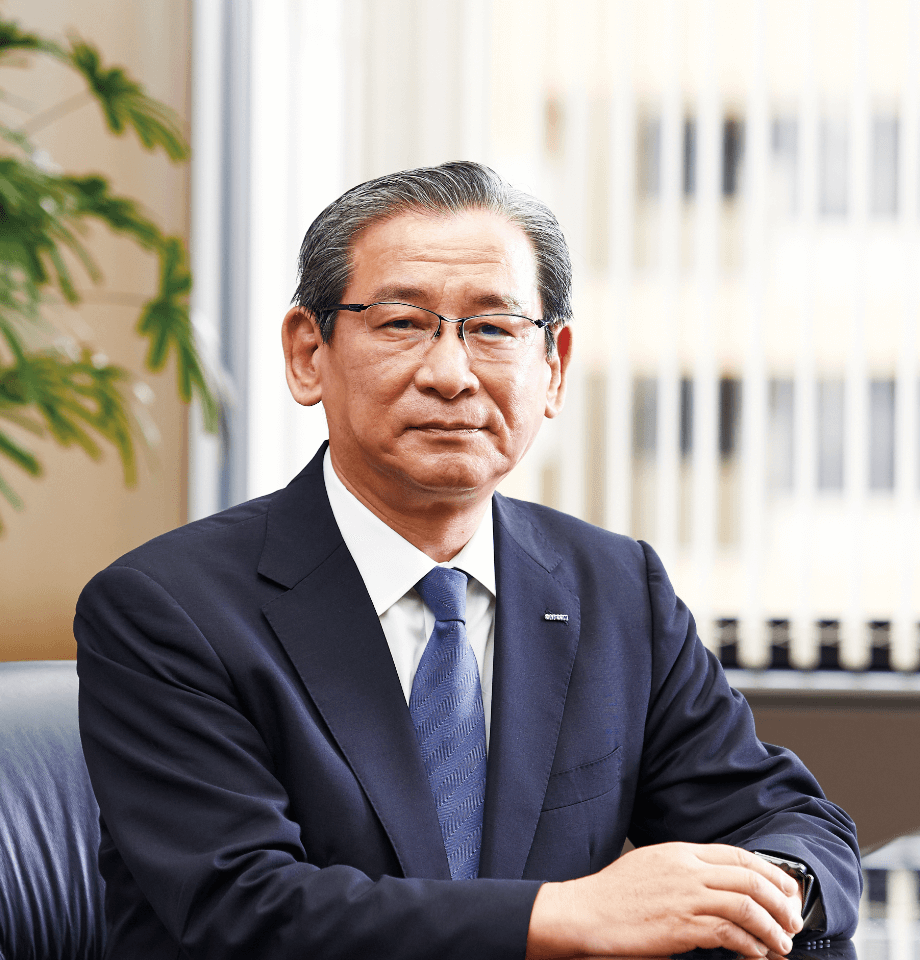- Value Creation
Story (PDF) - CEO
Commitment - COO Growth
strategy - CHO
Commitment - CFO
Commitment - Development
- Corporate
Governance

Financial and investment strategies
for sustainable growth
— Aiming to strengthen our financial
base while increasing investment in our
growth strategy
Kenkichi Nomura
Director, Executive Corporate Officer
and Chief Financial Officer (CFO)
-
-
Medium-term management plan progress
Capcom has put forth increasing operating income by 10% each fiscal year as our management goal, and we are working to expand users across the globe, aiming to eventually achieve 100 million units in annual sales of our games. In the fiscal year ended March 2022, annual sales units of games stood at 32.6 million in the Digital Contents business, which was an 8.3% increase from the previous year. Of those units sold, catalog titles released March 2021 and earlier totaled 24 million units sold, accounting for 73.6%. Unit sales of catalog titles increased 17.1% over the previous year, which significantly contributed to the overall increase in sales.
Similarly, the increase in sales of catalog titles was a major factor in the 22.4% year-on-year increase in operating income in the Digital Contents business. The operating income margin surpassed 50% in the business, and was the driving force in our overall consolidated results.
Sales of high-profit margin catalog titles have steadily increased, and our profit structure, which is the bedrock for consolidated profits, has stabilized.
We estimate ourselves as having made steady progress toward our goal of steadily expanding operating income independent of the sales performance of new titles.
The status of our financial base – particularly cash flow
-
In last year’s Integrated Report, we reported that changes to our revenue structure in recent years had resulted in a strengthened financial base. A comparison of the results from five years ago to the fiscal year ending March 2022 is shown in the table.
This time, we have added the statuses of operating cash flow (excluding working capital), cash, and ROI of the development divisions.
The first point to take note of with regard to our financial position for the year ended March 2022 is that our cash on hand and net cash have surpassed 100 billion yen. One of the most important responsibilities of my work is ensuring a stable cash balance and securing resources for growth investments. My thoughts regarding our capability to generate cash are outlined below.
-
Monitoring our capability to generate cash
Unlike accounting profits, operating cash flow in financial statements are impacted by variable working capital cycles relating to accounts receivable and payable, and work-in-progress for game software, and other items, which were incurred based on accounting principles. Among the items comprising working capital, accounts receivable in the last month of the fiscal year fluctuates significantly depending on the sales in the same month. For example, if a new title is released in March, there will be a large increase in both accounts receivable and profit, but that will not be reflected in cash on hand and in banks in the same fiscal year. However, our accounts receivable is mainly in digital sales and the number of customer accounts are limited, so there are no issues with managing receivables and almost all collections take place in the following month or two. In the fiscal year ended March 31, 2022, the balance of cash on hand and in banks on the balance sheet increased to 36 billion yen. Seeing this as a change in the operating cash flow, the increase on the cash flow statement is 46.9 billion yen, of which there is a positive impact of approximately 11.7 billion yen from a decrease in working capital attributable to the collection of accounts receivable. Excluding this, I consider our cash generating capability to be 35.2 billion yen in the fiscal year ended March 2022. From this, taxes and dividends are paid and what remains are the investment resources generated by our business results for the fiscal year.
-
On the other hand, operating cash flow reported a decrease of 5.5 billion yen in the three-month period ended June 2022 (FY2023 Q1 results), but similarly, taking into account the working capital cycle, there is a negative impact of 15.8 billion yen mainly due to increased accounts receivable, and excluding this, we can see that our actual capability of generating cash was 10.3 billion yen. From this amount, we paid 11.2 billion yen in first quarter taxes and dividends.
It is in this way that I am constantly observing the cash flow trend excluding the impact of the working capital cycle.
-
Aiming both to increase cash and strengthen growth investment
-
The underlying nature of Capcom’s business is hit-driven. In recent years, due to the efforts of our development team, new titles have exceeded the expectations of the market and game players, greatly contributing to our performance. We can see this in the improvement in ROI compared to five years ago (here, ROI refers to the ratio of operating income to funds invested in content production). However, I believe that especially since the business environment is undergoing significant, market-wide changes, the CFO must adopt a “we cannot know until we release it” stance. The planned annual development investment budget for fiscal 2022 is 42 billion yen. Adding the necessary investment for growth, which I will discuss later, I believe there is a need to secure an even higher cash balance.
-
Cash balance outlook
In the earnings forecast we announced for the fiscal year ending March 2023, we expect 120 billion yen in net sales, operating income of 48 billion yen, and net income for the year of 34.5 billion yen. Without taking into account the detailed tax calculations, after dividends are paid out from net income, our estimates show a cash increase of 24 billion yen. In reality, the actual cash increase will not be exactly as listed above due to investments and unplanned expenses during the fiscal year, but we use this figure as a reference to grasp the midterm cash flow trend.
Looking at the financial position in this way, our management goal of a 10% increase in operating income every fiscal year should lead to an increase in net income and steady cash growth, and we will manage investments and expenditures with that in mind. In other words, we will invest for growth from a medium-term perspective while monitoring our annual cash generating capability and ensuring a trend of increased cash.
Investing in sustainable growth
Human resources investment strategy
As one aspect of restructuring our human resources investment strategy, Capcom raised annual base compensation by 30%. This translates directly into increased costs and expenses. Taking into account factors such as the timing of bonus payments, we expect the impact on the results for the fiscal year ending March 2023 to be approximately 5 billion yen. Although this has already been factored into the forecast for the same fiscal year, we do not view this as a simple cost increase. Considering that this measure will further drive our employees’ motivation to address various issues, this raise in compensation is an investment in human resources, and our aim is that this investment will lead to a cycle of generating further profits and cash.
With regard to hiring, we will continue our policy of securing more than 150 new employees annually, and as we promote work style reforms, we are also considering investing in expanding development space.
Investing to respond to business environment changes
At Capcom, we are promoting the global expansion of our sales territory and user base, but game devices and sales channels are diversifying and there are an increasing number of options for game players. Earning favorable reviews from game players enables long-term sales of content, and in order to do that, our development team works on producing game content while keeping in mind the concept of delivering a new game experience to users. Our development team already has world-class technological capabilities, and we are constantly gathering information on the latest technology, including peripheral areas that can likely be used in games. We will continue to flexibly and swiftly invest in these areas.
Similarly, we are focusing on user trends in our sales activities, as we must grasp user trends and implement responsive measures quicker than ever before. We have already started research into AI and other methods to speed up data collection and analysis, and we will actively invest in order to expand the data collected and capture more detailed and wide-ranging user trends. We are taking proactive steps to acquire the skills and know-how that we lack, including securing external resources. In that sense, we are continuing to enhance our security levels, remembering the harm caused by the unauthorized access of our network in November 2020. We will continue to steadily strengthen our security measures going forward.
Investing in brand expansion and penetration
Capcom’s game sales have already expanded to more than 200 countries and regions as of the start of the fiscal year ending March 2023, and the annual number of different titles sold has exceeded 300. In order to achieve sustainable growth, the core of our tactics is to expand sales across the entire world. Going forward, it will be important to increase sales volume in the various countries and regions in which we sell. For example, in areas where the current annual sales volume is less than 100 units, we want to grow sales to more than 1,000 or 10,000 units; likewise, in countries and regions where annual sales are less than 1,000 units, we want to grow volume to more than 10,000 or 100,000 units.
One of Capcom’s strengths are the numerous strong IP that we possess, but if we look across all of the individual countries and regions in the world, we still have to work to penetrate and expand our game brands as well as Capcom’s corporate brand. As one measure toward brand expansion, we have entered into sponsorship agreements with the Japan Volleyball Association, which supports the Japanese national team as they travel around the world in competition, and Cerezo Osaka, which is developing an Asian strategy in the operation of its soccer club.
In addition, we also believe it is important that we establish an environment in which we can demonstrate the synergistic effect of our game sales business and its peripheral businesses.
For example, in April Capcom announced the establishment of Capcom Pictures Inc. to strengthen our media business. The main aim here is to further expand our brand by adding in-house production to our media business model, which had primarily been a license-out model until now. Specifics will be provided along with the progress we make moving forward, but similarly, we will also link our eSports and licensing businesses.
Addressing ESG & SDGs
At Capcom, we would like as many people as possible around the world to enjoy our game content, and it is from that perspective as well that we will continue to be proactive in addressing ESG and SDGs. When we first launched our policy to expand and strengthen digital sales five years ago, we were also thinking about how digitalization would reduce the use of plastic resources. In recent years, the issues surrounding climate change are being taken very seriously. From June 2022, in our buildings in the Kansai region that house mainly development divisions, with the support of Kansai Electric Power Company, we have implemented CO2-free electricity derived from renewable energy sources.
We will continue to actively examine what Capcom can do as a company regarding these issues from the perspective of corporate citizenship.
Regarding shareholder returns accompanying corporate growth
Our approach to shareholder returns remains the same. We will continue to strive for stable dividends with a basic policy of maintaining a consolidated dividend payout ratio of 30%. As of the fiscal year ended March 2022, we have achieved six consecutive years of increased dividends, if you take stock splits into consideration, and we hope to continue to achieve steadily increasing dividends by continuing to demonstrate stable growth performance. I recognize that acquiring treasury stock is one of the most important policies that contributes to return of profits to shareholders, so we will take the appropriate action as opportunities arise when we can determine that it will contribute to an increase in stock value, as we have done in the past. Meanwhile, we have been reviewing the specific ways and appropriate timing of treasury stock use, and from the fiscal year ending March 2023, we have introduced a stock grant ESOP trust that issues company stock to employees when they have reached a certain number of consecutive years with the company, or reached a certain position, or at the time of their retirement. In addition, all 4,387,353 shares of the Company’s stock we acquired in June 2022 have been cancelled.
According to our estimates, as of the fiscal year ended March 2022, the cost of capital (WACC) was 4.69%. We focus on ROE rather than ROIC because of Capcom’s high capital adequacy ratio and small amount of debt, and our ROE for the same period (24.4%) far surpasses this number. We will continue to achieve our medium-term goal of a stable increase in operating profits each year, which will help us maintain our high standards and meet the expectations of our shareholders.
CAPCOM INTEGRATED REPORT 2022
PDF (Complete version) (PDF: 12.2MB / 104 pages)
PDF (by section)
Value Creation Story
(PDF: 3.5MB / 24 pages)
- Create Financial and Non-Financial Value
- Corporate Philosophy
- Value Creation Model
- History of Value Creation
- Major Intellectual Properties (IP)
- Effectively Leveraging IP
- Digital Strategy / Human Resources Strategy Performance
- ESG Highlights
- Business Segments Highlights
- Financial Highlights
- Medium- to Long-Term Vision











